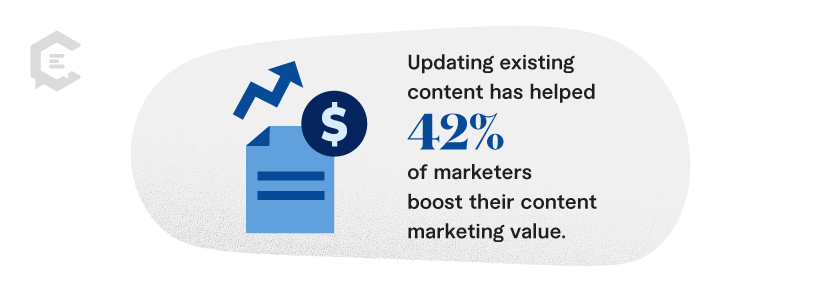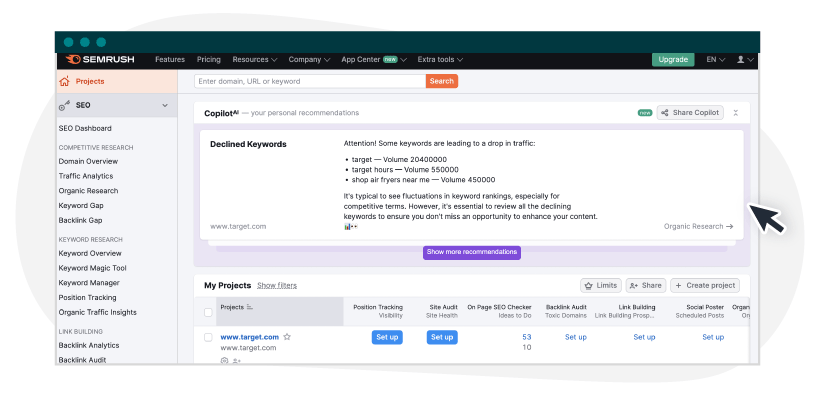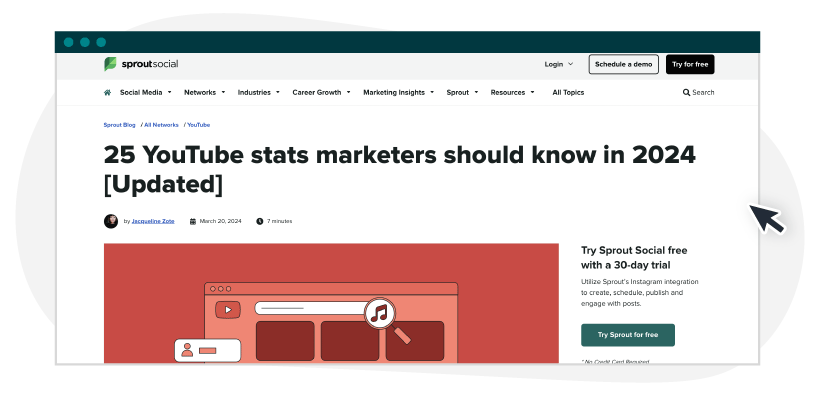A decline in traffic for your once highly popular blog post or a drop in engagement for your top-performing pieces clearly signals it’s time for a content refresh.
Information runs stale as new trends and technology result in industry changes. The instructions you provide on how to use one platform could easily be out of date by the next year as the platform gets updated. So you leave your readers confused, not knowing whether to trust the information you provide.

This makes it crucial to constantly update your content with the latest information to maintain its value and relevance. That way, you can adapt to meet your audience’s changing needs. In fact, updating existing content has helped 42 percent of marketers boost their content marketing value.
In this post, we explore how to identify underperforming content and how to refresh them. We also show you how to measure the impact of your content refresh and how to prevent future content decay.

The Causes and Signs of Content Decay
Your content can lose its relevance and effectiveness over time because of a number of reasons:
- Evolving information: Industries evolve as new trends and technology emerge, resulting in new information. Content referencing outdated statistics or practices becomes less relevant, losing credibility and user trust.
- Search engine algorithm changes: Search engines like Google prioritize fresh and relevant content. Content that hasn’t been updated to align with current ranking factors may see a decline in visibility.
- Audience interest shifts: User needs and expectations evolve. Content that once resonated with your audience might no longer address their current pain points or interests.
- Broken links and outdated resources: Links can become inactive, and resources referenced might no longer exist. This can be a frustrating experience for people reading your content. It also harms your SEO efforts as search engines can no longer index the page.
As these factors influence your content performance, you’ll start noticing the following signs:
- Declining organic traffic: A drop in organic website visits to a specific piece of content indicates potential decay, provided the drop happened consistently over time.
- High bounce rate: If users leave your page shortly after landing, it suggests your content doesn’t meet their expectations. This could be because it doesn’t contain the latest information they seek.
- Low engagement metrics: A lack of comments, shares, time on site, and social media engagement points toward declining content value. It means that people are no longer engaging with your content.
- Negative user reviews: Direct feedback from your audience could also help you identify outdated or underperforming content. Your audience may comment on the post highlighting outdated information or irrelevant content.
- Backlink decline: Backlinks are like votes of confidence for your content. A decrease in backlinks might indicate a reduced value in the eyes of other websites.

Identifying Underperforming Content
Assumptions alone aren’t enough to identify underperforming content. It’s important to take a data-driven approach and perform a thorough content analysis to pinpoint content that’s losing its shine. Use the following tools to track your content performance and see which ones need updating:
- Analytics platforms: Tools like Google Analytics and Adobe Analytics help you identify trends in organic traffic, bounce rates, and average time spent on page for specific content pieces. A decline in these metrics could indicate content decay.
- Search Console data: Use Google Search Console to track your content’s ranking for relevant keywords. A significant drop in ranking could signify a need for revitalization.
- Content audit tools: Consider dedicated content audit tools like Semrush or Screaming Frog to analyze large datasets of content. These tools are highly effective for identifying broken links and SEO optimization opportunities.

- Social listening tools: Tools like Brandwatch and Sprout Social help you understand audience sentiment and identify content gaps. See the conversations people are having about your brand and content. This will help you adapt your content revival strategy to address their specific content needs.
These tools provide a wealth of data about your website and content performance. You need to filter this information to focus on the right data to understand which pieces are underperforming. The following key metrics can help you measure content performance:
- Organic traffic: Look for signs of decline in the number of visitors who found your content organically through search engines.
- Bounce rate: See if there’s a high percentage of visitors who leave a page after viewing just one page.
- Average time on page: Look for a drop in the average amount of time people spend engaging with your content.
- Engagement metrics: Identify a consistent decline in engagement actions such as social shares and comments.
- Conversions: Track the number of visitors who take a desired action on your website, such as signing up for a newsletter or making a purchase.
- Backlinks: Measure changes in other websites linking to your content, indicating its authority and relevance.
Strategies for Content Refresh and Revival
Your content being outdated doesn’t necessarily mean you no longer have use for it. You could still get some value out of it with some punch-ups and updates. Here are a few strategies to refresh and revive outdated and underperforming content.

Content repurposing and updating
In most cases, you can update your content with new information to refresh it a little. This will enhance its value and strengthen its appeal to your audience.
Update your content according to the latest trends and data from reliable sources. Conduct a content audit and go through the existing information to see if there have been any changes since you first published it. Check the reports and studies you cited to see if there are new findings that you can use.
Sprout Social, for instance, makes annual changes to its platform-specific stats listicles.

If possible, consider adding new sections or subsections that address emerging topics within your field. Offer deeper insights to enhance value through new examples, case studies, and expert quotes.
You can even repurpose some of your top-performing pieces into different formats to reach a wider audience. Convert blog posts into infographics or videos or create bite-sized social media content based on existing long-form pieces.
SEO and keyword refresh
The latest Google algorithm updates could influence how your content ranks for relevant keywords. To stay on top of these updates, you need to refresh your content regularly. Moreover, as new competitors emerge targeting the same keywords as you, optimizing your existing content will help you maintain your position.
You can refresh your old blog posts for SEO by updating them with the latest trending keywords that align with the topic and search intent. Update the title tags and meta descriptions with the right keywords.
Additionally, improve your linking strategy by fixing broken links and linking to other relevant content within your website. Link your refreshed content to relevant pages within your website to improve user flow and search engine ranking. Don’t forget to use highly relevant anchor texts when linking to other pieces of content.
It’s also essential to fix any technical SEO issues that could impact your content’s visibility.

Design and visual enhancements
Outdated visuals negatively impact the user experience. Imagine someone reading a blog post containing screenshots from an older version of an app. They’ll have a hard time following the instructions if the app layout from the screenshot no longer matches the latest version.
So it’s important to regularly refresh older images, screenshots, and other visual media according to the latest updates and design trends.
Content readability also plays an important role in the overall user experience. Huge text blocks and awkward formatting can make your content difficult to read. So make sure to update your content format with readability in mind. This involves using relevant subheads, bullet points, and white space to break up huge text blocks.
Don’t forget about mobile users. When your content reads well only on desktop, mobile users will have to pinch and squint to read it. This is a recipe for higher bounces and lower engagements. So make sure every element displays flawlessly across all devices.
Measuring the Impact of Content Refresh
Updating your content is only one part of a larger content revival strategy. Once updated, you need to carry out a content analysis to ensure that your efforts have paid off. This involves keeping track of any changes in the key metrics you used to identify underperforming content.
- Traffic changes: Did organic traffic increase after the refresh? Remember that you might not see an immediate uptick. The traffic growth will typically increase gradually over time.
- Improved bounce rate and average time on page: Do you notice a drop in your bounce rate? Are people spending more time on pages with refreshed content?
- Increased engagement: Has there been a rise in user interaction, such as comments or shares? Pay attention to comments, social media engagement, and lead generation rates associated with the refreshed content.
- New backlinks: Track if the refreshed content attracts new backlinks. This is a strong indicator of improved authority and relevance.
- Increased conversion rate: Are visitors taking desired actions, like subscribing to your newsletter or making a purchase? Has your conversion rate increased compared to pre-content refresh?

Preventing Future Content Decay
An extensive content refresh may help you revive outdated and underperforming content. But there’s no guarantee that your refreshed content will eventually decay a couple of years down the line.
It’s vital to carry out ongoing content analysis to monitor performance declines and detect early signs of content decay. This will help you take necessary precautions to refresh your content before its performance drops further.
On that note, you need to schedule regular content updates so that your content doesn’t have time to become outdated in the first place. According to an analysis by Siege Media, the frequency of content refresh depends on the type of content and the target keywords. Generally, content that ranks on page one for popular keywords has been updated in the past 1.31 years on average.
Product-focused content targeting keywords containing “best” tends to see more frequent updates at an average of 235 days. Similarly, keyword variants containing “rates” see frequent updates at an average of 246 days.
On the other hand, keywords containing “what is” and “how to” require less frequent updates. This indicates that the type of information associated with these keywords is more evergreen.
Gearing Up for a Successful Content Revival
From identifying which content pieces need updating and knowing how to update them — content refresh can be a challenging process. Fortunately, you can count on ClearVoice to provide powerful content solutions for your content revival needs.
Identify your content gaps and focus on the keywords that matter with our expert SEO content strategy. Then, implement your content refresh strategy with vetted content creators and a team to manage the entire content production. Connect with a ClearVoice content strategist today to get started.



